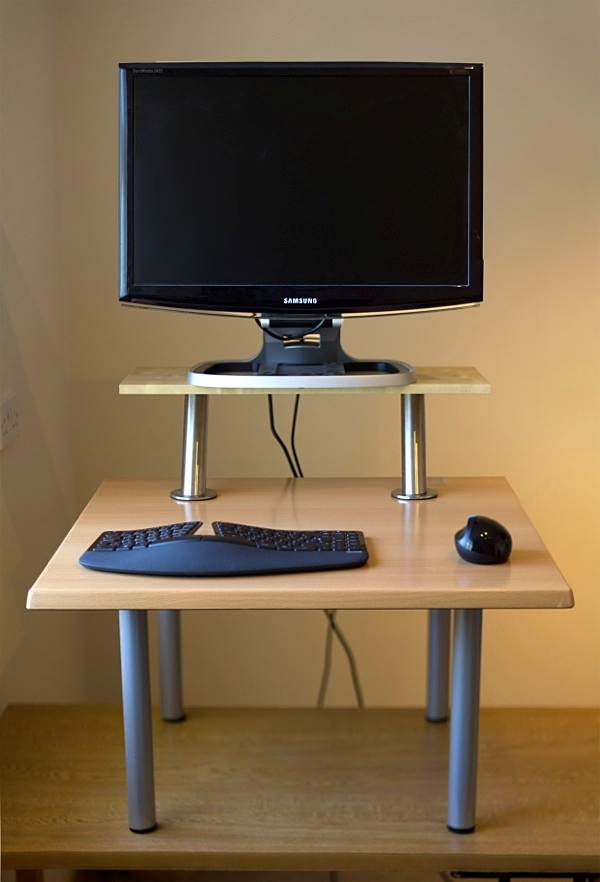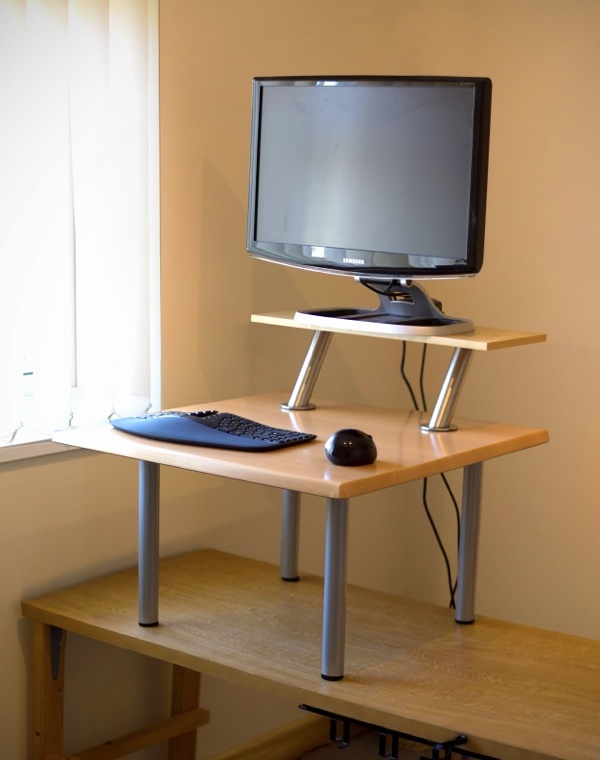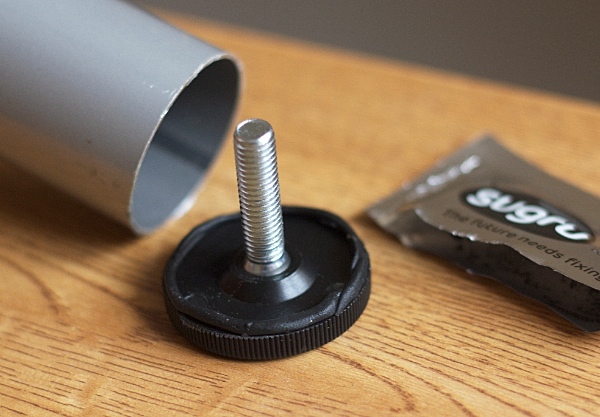A standing desk with (mostly) Ikea parts
Most developers by now are familiar with the standing desk trend. This post isn’t about the pros/cons, suggestions about how long you should stand for, or anything like that. Let’s just say that like me you want to give it a go, but you’re not inclined to spend many hundreds of pounds on a brand new high-end desk until you’re sure you really will use it for the next five years or so.
Many others have built their own standing desks before, even with Ikea parts. So this is hardly revolutionary. But it’s a good looking, inexpensive design, that others may find interesting.
Finished result
This standing desk sits on top of your existing sitting desk, and is designed to take up roughly half of a typical desk width. So you’ll have a half-sitting, half-standing desk, and can easily move between the two postures:

Pros:
- Transportable. Can easily move it around between desks/workplaces (unscrew the legs by hand, carry it over)
- Good ergonomics. Gives a lot of room around your keyboard and mouse, and keeps the monitor a pleasing distance from your face, compared with alternatives.
- Cheap(ish), versus commercial pre-built standing desks, yet looks professional.
Cons:
- Not height-adjustable, unless you count taking a hacksaw to the legs.
- Only wide enough for a single large monitor
- To be fair, there’s nothing to stop you putting on a wider shelf. It’s easily strong enough to take a second large monitor. It would just look a bit more imposing.
- However, since I switched back to having a single large monitor a few years ago, this is exactly how I want it. Less neck-swivelling = more comfort for me personally.
- Cheaper DIY alternatives exist
- Requires a trip to Ikea. But hey, meatballs, right?
Ingredients
Many of the following components can be substituted with alternatives, depending on what you have available. For example, there’s probably no real reason to use Sugru if you already have some strong glue such as Araldite. And any similar-sized piece of wood will do in place of the Ekby Laiva shelf.
From Ikea:
- 4 x Adils legs (£2.50 each)
- 1 x Capita bracket set (£10.00)
- 1 x Ekby Laiva shelf (£1.75)
Order online:
- 1 x 700mm Bolero square beech-effect table top (£26.99 plus shipping)
- (Optional) 1 x minipack of Sugru, black (£6.50 for 3 minipacks)
- (Optional) 1 x Dandy 70x40cm anti-fatigue mat (£23.25)
Total cost: from £41.24 to £70.99 depending on optional parts. But I do recommend some kind of mat. And I assume you have tools (a drill, a hacksaw) and a range of small screws, since the ones that Ikea include are too big.
Method
When you see the list of parts, it’s pretty obvious how to construct it. So I’m not going to list every screw, cut, or measurement – I’ll just give an outline with some tips. Here’s another viewpoint on the desk to clarify its arrangement:

Getting the right height
Start here because it’s the most important bit. I’ve read that your standing desk surface should be at roughly elbow-height, but I like mine about 8-10cm below that. You will need to account for the height of the underlying desk and thickness of the table top (obviously), and perhaps the height of your keyboard or anti-fatigue mat if either are big. You might want to first construct a mock-up by balancing the table top on some boxes or whatever.
When you’re sure of the height, measure the Adils legs from the circular bracket at the top downwards, and subtract from your measurement about 1cm to account for the feet you’ll attach later. Now hacksaw the legs to length, and retain the adjustable feet for later.
Screw the circular Adils leg brackets into the underside of the table top now, but don’t screw the legs into them just yet.
Fitting the monitor stand
Be careful when planning how far back to mount the monitor stand to ensure the monitor’s centre of gravity will end up within the desk’s four legs. For me, the desk’s size and the angle of the Capita brackets result in a pretty ideal natural distance from my face to the monitor, but individual preferences vary.
The Capita brackets are a bit baffling because there are so many possible ways of attaching them. I’d recommend first drilling the two 9mm(ish) holes in your table top, loosely bolting on the Capita brackets, and then marking out where the screw holes naturally land on the underside of the Ekby Laiva shelf.
Then drill pilot holes into the Ekby Laiva shelf, bolt the Capita brackets tightly to the table top, and finally screw the Ekby Laiva shelf to the top of the Capita brackets with some small screws.
Finishing the legs
You can now screw in the Adils legs to their brackets, and ta-da – your standing desk is usable. However the bottom end of the legs is just roughly sawn metal, which will make a mess of whatever desk it stands on.
Fortunately you can take the feet off the sawn-off parts of the Adils legs and attach them to the bottom of your new desk’s legs. You can stick them on with strong glue such as Araldite. Instead, I used rolled-out circles of Sugru (see photo below), partly just because I was in a “hack your stuff” mood, and partly because it let me compensate for some irregularities in my unskilled hacksawing:

Review
I’ve only been using this for a few weeks now, but the desk feels great to use – it’s sturdy, spacious, and looks good in my office. My elbow pain (the reason I did this in the first place) was gone after the first two days. I tend to stand through the morning and sit in the afternoon, though maybe I should reverse the order to minimise post-lunch lag.
After the first couple of multi-hour standing-working sessions, it was clear I couldn’t just stand on carpet in socks (or shoes) for hours. Your feet will probably tell you the same. I stood on a foam pillow for the next few days, and it was hugely better. For a better, more long-term solution, follow the advice of standing-mat devotees everywhere and get a nice gel mat to stand on, such as the Dandy one I mentioned above. These mats are a bit pricey, but feel so much better.